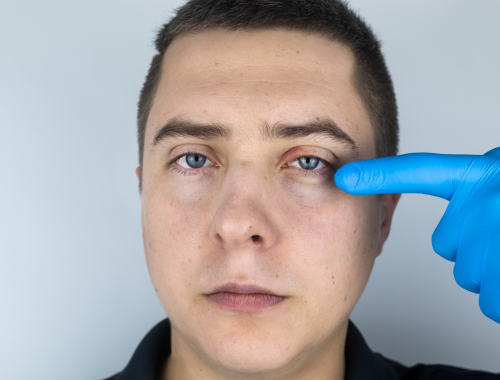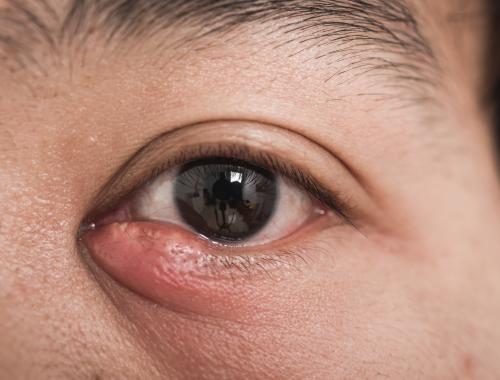Difference Between Blepharitis and Hordeolum
Blepharitis is the inflammation of the eyelids, caused by irritation of the eyelid lining and clogging of the oil glands in the eyelid. Hordeolum or stye is a tender red bump on the eyelid that is secondary to bacterial infection of the oil gland in the eyelid.

What is blepharitis?
Definition:
Blepharitis is the inflammation of the eyelids, caused by irritation of the eyelid lining and clogging of the oil glands in the eyelid.
Causes:
Blepharitis is caused mainly by meibomian gland dysfunction, which is the oil-producing gland for tears. Acne rosacea, allergies, seborrheic dermatitis, dry eyes, and mites in eyelashes are the most common causes of blepharitis.
Symptoms:
Symptoms of blepharitis are swollen edematous, greasy eyelids, red eyes that are itchy, dry eyes, crusted eyelashes, sticky eyes, repetitive blinking, photophobia, flaky skin around the eyelids, blurring of vision and eyelashes growing towards the eyes (trichiasis).
Risk factors:
Risk factors for developing blepharitis are diabetes, chronic exposure to dust, living in dry weather, wearing contact lenses frequently, having oily skin, not removing makeup thoroughly, menopausal women, and those on cancer therapy.
Diagnosis:
Diagnosis of blepharitis is made after taking a just, doing an external eyelid examination, and taking a culture of eye discharge. A tear test can be done to identify dry eyes. An eyelash exam under the microscope is done to detect mites. Only rarely an eyelid biopsy is taken if skin cancer is suspected.
Treatment:
At-home measures to reduce blepharitis include avoiding eye makeup, using warm compresses to clean the eyelid, and using lid scrubs to reduce dandruff on the lashes. A healthcare provider will identify the cause of blepharitis and may prescribe antibiotics ointments like erythromycin, or bacitracin in case of bacterial infections and steroid eye drops or cream in case of inflammatory causes.

What is hordeolum?
Definition:
Hordeolum or stye is a tender red bump on the eyelid that is secondary to bacterial infection of the oil gland in the eyelid.
Causes:
Hordeolum occurs due to bacterial infection of the meibomian glands in the eyelid. The bacteria involved is Staphylococcus aureus. The infection is likely to occur if you touch your eyes repetitively without proper hand washing, use dirty contact lenses, use frequent eye makeup, or have another eye condition.
Symptoms:
Hordeolum is a painful tender bump on the eyelid. It can present with redness on the eyelid, watery eyes, and a gritty sensation in the eyelid especially after waking up.
Diagnosis:
Hordeolum is diagnosed after medical history to evaluate the symptoms and through a physical examination of the eyelid.
Treatment:
At-home treatment of hordeolum includes warm compresses for 10 to 15 minutes using a clean towel and gentle massages over the swelling. A stye should never be popped or squeezed. Antibiotics may be prescribed if the infection spreads to the eye. Lastly, sometimes an incision may be required to drain the stye.
Difference between Blepharitis and Hordeolum
Definition:
Blepharitis is the inflammation of the eyelids, caused by irritation of the eyelid lining and clogging of the oil glands in the eyelid. Hordeolum or stye is a tender red bump on the eyelid that is secondary to bacterial infection of the oil gland in the eyelid.
Causes:
Blepharitis is caused mainly by meibomian gland dysfunction, which is the oil-producing gland for tears. Acne rosacea, allergies, seborrheic dermatitis, dry eyes, and mites in eyelashes are the most common causes of blepharitis. Hordeolum occurs due to bacterial infection of the meibomian glands in the eyelid. The bacteria involved is Staphylococcus aureus. The infection is likely to occur if you touch your eyes repetitively without proper hand washing, use dirty contact lenses, use frequent eye makeup, or have another eye condition.
Symptoms:
Symptoms of blepharitis are swollen edematous, greasy eyelids, red eyes that are itchy, dry eyes, crusted eyelashes, sticky eyes, repetitive blinking, photophobia, flaky skin around the eyelids, blurring of vision and eyelashes growing towards the eyes (trichiasis). Hordeolum is a painful tender bump on the eyelid. It can present with redness on the eyelid, watery eyes, and a gritty sensation in the eyelid especially after waking up.
Diagnosis:
Diagnosis of blepharitis is made after taking a just, doing an external eyelid examination, and taking a culture of eye discharge. A tear test can be done to identify dry eyes. An eyelash exam under the microscope is done to detect mites. Only rarely an eyelid biopsy is taken if skin cancer is suspected. Hordeolum is diagnosed after medical history to evaluate the symptoms and through a physical examination of the eyelid.
Treatment:
At-home measures to reduce blepharitis include avoiding eye makeup, using warm compresses to clean the eyelid, and using lid scrubs to reduce dandruff on the lashes. A healthcare provider will identify the cause of blepharitis and may prescribe antibiotics ointments like erythromycin, or bacitracin in case of bacterial infections and steroid eye drops or cream in case of inflammatory causes. At-home treatment of hordeolum includes warm compresses for 10 to 15 minutes using a clean towel and gentle massages over the swelling. A stye should never be popped or squeezed. Antibiotics may be prescribed if the infection spreads to the eye. Lastly, sometimes an incision may be required to drain the stye.
Table of differences between Blepharitis and Hordeolum

FAQs
How can you tell the difference between a stye and blepharitis?
Stye is a single painful bump on the eyelid whereas blepharitis is the inflammation of the eyelids.
What is the difference between blepharitis and chalazion and hordeolum?
Blepharitis is the inflammation of the eyelids, caused by irritation of the eyelid lining and clogging of the oil glands in the eyelid. A chalazion, also known as a meibomian cyst, is a red bump on the eyelid. Hordeolum is a tender, painful pimple-like bump on the eyelid.
What is the difference between blepharitis and chalazion?
Blepharitis is the inflammation of the eyelids, caused by irritation of the eyelid lining and clogging of the oil glands in the eyelid. A chalazion, also known as a meibomian cyst, is a red bump on the eyelid.
Can blepharitis cause hordeolum?
Yes.
What is the first stage of blepharitis?
Lash misdirection is the first stage of blepharitis.
What does the start of blepharitis look like?
Greasy eyelids with flaky skin around them.
- Differences Between Reptiles and Amphibians - May 17, 2024
- Difference Between Ophthalmology and Optometry - May 15, 2024
- Difference Between Fear and Anxiety - April 2, 2024
Search DifferenceBetween.net :
Leave a Response
References :
[0]Bragg, Kara J., Patrick H. Le, and Jacqueline K. Le. "Hordeolum." (2017).
[1]Bernardes, Taliana Freitas, and Adriana Alvim Bonfioli. "Blepharitis." Seminars in ophthalmology. Vol. 25. No. 3. Taylor & Francis, 2010.
[2]McCulley, James P., Joel M. Dougherty, and David G. Deneau. "Classification of chronic blepharitis." Ophthalmology 89.10 (1982): 1173-1180.
